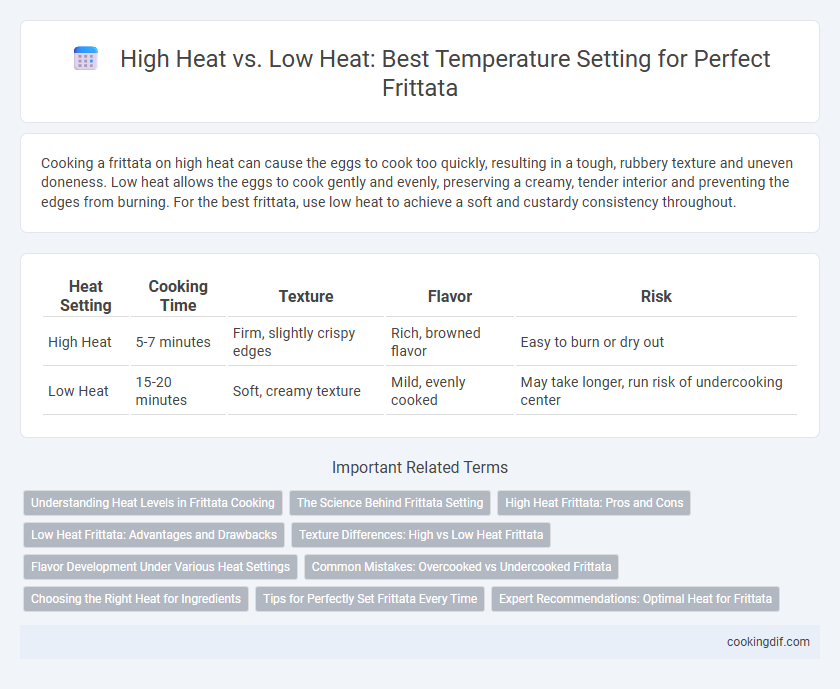Cooking a frittata on high heat can cause the eggs to cook too quickly, resulting in a tough, rubbery texture and uneven doneness. Low heat allows the eggs to cook gently and evenly, preserving a creamy, tender interior and preventing the edges from burning. For the best frittata, use low heat to achieve a soft and custardy consistency throughout.
Table of Comparison
| Heat Setting | Cooking Time | Texture | Flavor | Risk |
|---|---|---|---|---|
| High Heat | 5-7 minutes | Firm, slightly crispy edges | Rich, browned flavor | Easy to burn or dry out |
| Low Heat | 15-20 minutes | Soft, creamy texture | Mild, evenly cooked | May take longer, run risk of undercooking center |
Understanding Heat Levels in Frittata Cooking
Cooking a frittata on low heat ensures even cooking and prevents the eggs from burning or becoming rubbery, resulting in a creamy texture. High heat risks overcooking the edges while leaving the center underdone, causing uneven texture and flavor. Mastering the right heat balance enhances the frittata's tenderness and overall taste.
The Science Behind Frittata Setting
Cooking a frittata at high heat rapidly sets the eggs' proteins, creating a firm exterior but risking a burnt bottom and undercooked interior. Low heat allows gradual coagulation of egg proteins, ensuring even cooking and a tender, creamy texture throughout. The key lies in balancing heat to control protein denaturation and moisture retention for optimal flavor and texture.
High Heat Frittata: Pros and Cons
Cooking a frittata on high heat allows for rapid setting and browning, creating a crisp exterior while locking in moisture, which enhances texture and flavor. However, using high heat increases the risk of uneven cooking, with the exterior potentially burning before the interior is fully set, leading to a tough or undercooked center. Optimal results require careful attention and quick temperature adjustments to balance a golden crust and a tender, creamy interior.
Low Heat Frittata: Advantages and Drawbacks
Cooking a frittata on low heat ensures even cooking and prevents burning, resulting in a tender and fluffy texture with well-cooked eggs and fillings. Low heat allows for gentle heat distribution, reducing the risk of overcooked edges or an undercooked center, making it ideal for delicate ingredients like vegetables and cheese. However, this method requires more patience and time, which may lead to longer cooking durations and potential moisture retention issues if not monitored carefully.
Texture Differences: High vs Low Heat Frittata
Cooking a frittata on high heat results in a firmer, crispier crust with a slightly denser interior, while low heat produces a softer, creamier texture throughout. High heat tends to cook the eggs rapidly, creating distinct layers and a golden-brown exterior, whereas low heat allows for gentle, even cooking that prevents browning and maintains moisture. Choosing between high and low heat affects not only the consistency but also the flavor profile and visual appeal of the finished frittata.
Flavor Development Under Various Heat Settings
Cooking a frittata over high heat develops a rich, caramelized crust that intensifies flavors and creates a slightly crispy texture, enhancing the overall taste experience. Conversely, low heat ensures gentle cooking that preserves the delicate balance of ingredients, resulting in a creamy interior with subtle, well-blended flavors. Optimal flavor development balances the Maillard reaction from moderate heat with slow coagulation to prevent bitterness and maintain a tender, flavorful frittata.
Common Mistakes: Overcooked vs Undercooked Frittata
Cooking a frittata on high heat often leads to a burnt bottom while leaving the center undercooked, a frequent mistake that compromises texture and flavor. Low heat ensures even cooking by gently setting the eggs, preventing dryness and preserving the frittata's creamy consistency. Mastering temperature control between these extremes is essential for achieving the perfect balance between a tender interior and a slightly golden crust.
Choosing the Right Heat for Ingredients
Choosing the right heat for cooking a frittata is essential to achieving the perfect texture and flavor. High heat works well for cooking ingredients like onions, bell peppers, or mushrooms quickly, ensuring they retain their moisture and develop a slight caramelization. Low heat is ideal for gently cooking eggs and delicate ingredients such as spinach or herbs, allowing the frittata to set evenly without burning or becoming rubbery.
Tips for Perfectly Set Frittata Every Time
Cooking a frittata over medium-low heat ensures even cooking and prevents the edges from burning before the center sets. Using a non-stick skillet and covering it with a lid or finishing under a broiler helps achieve a perfectly set top without overcooking. This technique retains moisture and produces a tender, fluffy texture ideal for a balanced frittata.
Expert Recommendations: Optimal Heat for Frittata
Expert recommendations for cooking frittata emphasize using medium to low heat to ensure even cooking without burning the eggs or ingredients. High heat may cause the edges to overcook while leaving the center undercooked, resulting in an uneven texture. Maintaining a gentle heat allows the frittata to set properly and develop a creamy consistency.
High heat vs Low heat for frittata setting Infographic

 cookingdif.com
cookingdif.com